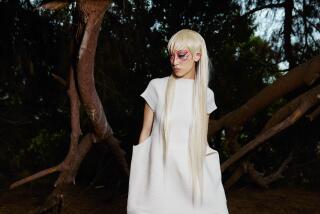‘Post-Butoh’ or Just Kim Itoh’s Interpretation?
- Share via
The work of Japanese choreographer Kim Itoh has been called “post-butoh,” but since the postwar modern dance genre of butoh has never been easy to define, that could be just about anything. In the case of Itoh and his small company, the Glorious Future, it seems to mean that, like butoh, there is much agonizingly slow movement and a fair sprinkling of anguished puppet gesture, but there are also little jokes built in--not a butoh staple.
In two works by the company at the Japan America Theatre on Saturday night, the barely clothed body was alternately a bent and brave thing, often washed with significance by great music. Itoh himself was the most poetic mover, a classically etched sculpture who flipped into stately or crumpled poses to resonant Bach in “3 Sex,” and, in “Dead and Alive: Body on the Borderline,” a monk-like figure who wavered and moved to moonlit Ravel and then paused in drawn-out curves as beaming light illuminated his white robe.
At many points, dancers were affected by light. Before Itoh’s solo in “3 Sex,” he and Mayu Sasajima and Mari Saeki were under separate naked light bulbs in transparent tents, rising and collapsing like aerobic exercisers in a trance. In “Dead and Alive,” Itoh made a drawn-out crossing in crouched poses that resembled Isadora’s repressed peasant in “Marche Slav,” while three men crossed behind him the opposite way, the low light catching curves and crannies of their naked bodies.
The unclothed figures at first seemed seriously downtrodden, hands covering their eyes or cupping their genitals. Then they suddenly started wrestling with their nether regions to the racing violins of Mendelssohn. When the music stopped, they exited, exhaling with exaggerated relief. Pathos and putzes--seems just right for the category of post-butoh.
More to Read
The biggest entertainment stories
Get our big stories about Hollywood, film, television, music, arts, culture and more right in your inbox as soon as they publish.
You may occasionally receive promotional content from the Los Angeles Times.










